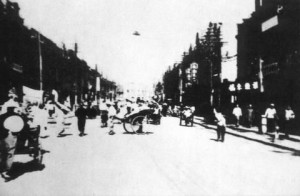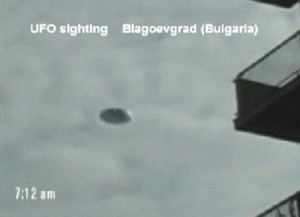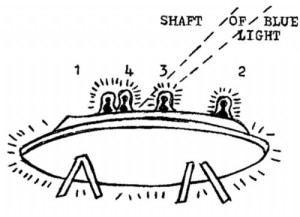THINK ABOUTIT SIGHTING REPORT
Date: October 1, 1996
Sighting Time:
Day/Night:
Location: Bonnybridge area, Scotland
Urban or Rural: –
No. of Entity(‘s):
Entity Type:
Entity Description:
Hynek Classification: NL (Nocturnal Light) Point or extended luminous source observed at night. CE-V (Close Encounter V) Voluntary bilateral contact between humans and extraterrestrials.
Duration:
No. of Object(s): 1
Height & Speed:
Size of Object(s):
Distance to Object(s):
Shape of Object(s): Triangle
Color/Description of Object(s):
Number of Witnesses: Multiple
Source: Shari Adamiak, CSETI (Center for the Study of Extraterrestrial Intelligence) Source
Summary/Description: On October 1, 1996, a small Rapid Mobilization Investigative Team (RMIT) was activated by CSETI’s director and founder, Steven Greer M.D. The team journeyed to the Bonnybridge, Scotland area – the scene of continuing, persistent UFO activity since the current wave began in 1994.
Full Report
Background on the CE-5 (Close Encounters of the Fifth Kind) Initiative by CSETI (Center for the Study of Extraterrestrial Intelligence) (Director: Steven Greer, MD – Website: www.cseti.org):
Definition: CE-5 is a term describing a fifth category of close encounters with Extraterrestrial Intelligence (ETI), characterized by mutual, bilateral communication rather than unilateral contact. The CE-5 Initiative has as its central focus bilateral ETI-human communication based on mutual respect and universal principles of exchange and contact. CE types 1-4 are essentially passive, reactive and ETI initiated. A CE-5 is distinguished from these by conscious, voluntary and proactive human-initiated or cooperative contacts with ETI. Evidence exists indicating that CE-5s have successfully occurred in the past, and the inevitable maturing of the human/ETI relationship requires greater research and outreach efforts into this possibility. While ultimate control of such contact and exchange will (and probably should) remain with the technologically more advanced intelligent life forms (i.e., ETI), this does not lessen the importance of conscientious, voluntary human initiatives, contact, and follow-up to conventional CE-s types 1-4.
CSETI is the only worldwide effort to concentrate on putting trained teams of investigators into the field where 1) active waves of UFO activity are occurring, or 2) in an attempt to vector UFOs into a specific area for the purposes of initiating communication. Contact protocols include the use of light, sound, and thought. Thought – specifically consciousness – is the primary mode of initiating contact.
—————————————————-
by Shari Adamiak, Research Director, Copyright 1996
On October 1, 1996, a small Rapid Mobilization Investigative Team (RMIT) was activated by CSETI’s director and founder, Steven Greer M.D. The team journeyed to the Bonnybridge, Scotland area – the scene of continuing, persistent UFO activity since the current wave began in 1994. Cohn Andrews, noted crop circle researcher, had initially informed us of the current wave. We had waited nearly two years to travel to Scotland and, amazingly the wave is still current.
We left Baltimore at 3.00 a.m. By dawn, we were landing for our first refueling stop in Goose Bay, Labrador/Newfoundland. Much to our delight, our next stop was Keflavik, Iceland. The world’s best-kept secret, Iceland and Greenland actually switched names as Iceland wished to keep itself tucked away at the top of the world. We flew in over offshore volcanic cones which created a terrain so lovely and eerie, it appeared to belong to another planet. Our pilots told us that these volcanoes create nearly a tropical summer climate, and that “Iceland” is covered with hot springs and waterfalls. We had been aware of Internet postings of reports of UFO sightings at “the top of the world” over the previous 3-4 weeks. We learned several days later that the volcano Loki, under Europe’s largest glacier, located in southern Iceland, erupted four hours after our brief visit.
We landed in Edinburgh Scotland in the early evening and were met by CSETI member Neil Cunningham. After Neil was introduced to us via the Internet, I met him in England during the summer. Although now a Londoner, Neil grew up in the Bonnybridge area. CSETI’s deepest thanks go out to Neil for being our advance person and ground crew prior to our arrival. After the usual delays with customs and rental car agencies, we traveled west to the Stirling/Denny area. We checked into the farmhouse B&B Neil had arranged for us whose owners graciously prepared a late supper for us. Then it was off to scout some of the sites where UFO activity had occurred. We met with Craig Malcolm who has started Skywatch Scotland. Craig showed us some of his recent video footage and accompanied us to a byway with a good view out over the Bonnybridge area. Except for some inconclusive distant lights, no events of importance occurred during our brief skywatch that night.
The next day dawned sunny and brisk. Autumn was just beginning to touch the emerald green landscape. We learned that we were staying in the head of the land where William Wallace’s battles for the freedom of Scotland took place, and where the movie about Wallace – “Braveheart” – was filmed. Walks around the vicinity revealed scenery so breathtaking it resembled fake movie backdrops.
With Neil as our guide, we continued our investigation of various sites around Falkirk, Bonnybridge, Shieldhill, and (oddly), California. Neil explained that Shieldhill was the site of an old Roman fort and mentioned that the Romans called UFOs flying shields. We wondered if sightings had occurred over the centuries and not just the last few years.
We visited Cairnpapple, Scotland’s little- known ‘Stonehenge’ and reckoned it as a possible field site. From atop the Neolithic mound, a 360 deg. range of vision afforded views of the Firth of Forth and both coasts. Cairnpapple is thought to be possibly older than Stonehenge. It looks down on the village of Torphichen, site of the preceptory that was the first temple of the Knights Templar. We learned the story of a gentleman who had been atop Cairnpapple one night when a very tall life form, appearing silvery, approached. The gentleman reported that the man, very possibly an extraterrestrial, was running across the countryside at about 70 miles per hour. When the lifeform came near, the witness reported that he ‘growled’ at him, frightening the man greatly. We suggested that perhaps it was not a growl at all but simply the life form’s normal if guttural, speech. The afternoon had turned cold, rainy, and windy. We knew that in order to use the hill at Cairnpapple for a nighttime field site, we would have to find a spot protected from the wind.
The weather remained inclement so we decided to go to the Shieldhill/California area where a pub/banquet hall’s parking lot afforded a spectacular view across the valley towards Stirling and Bonnybridge. As we were gathering our gear in the wind and rain, we heard the nearby sound of bagpipes. Looking around the corner, we saw a Scotsman in kilt piping for people from the banquet hall piling into a bus. It was lovely and poignant to hear the bagpipes in the rain.
We were able to set up a small camp on the backside of the building, out of the wind and rain. Craig Malcolm joined us later. After he did, we witnessed along a ridge later determined to be approximately 30 miles away, an unusual array of rapid pulsing blinking lights. At that distance, we estimated the lights could have been as much as a mile apart. But they seemed interrelated as the number of lights visible changed often and the blinking was erratic. All video cameras were trained on the lights with little success.
However, approximately 9-10 minutes later, a similar sequence of flashing lights appeared at the opposite end of the ridgeline. If these were some sort of conventional vehicles – say, emergency or highway trucks – we did not see how it would be possible for them to have traversed a serpentine dirt road 30-35 miles along a ridgeline in ten minutes or less. As we observed the lights through binoculars, they changed in number and moved erratically, one light even appearing to jump over another at one point. We learned later that Craig Malcolm’s video of this sighting came out quite clearly. The behavior and appearance of the lights is even more strange on video than it had appeared through the binoculars and night vision scopes.
Later that evening we moved our site to Take Me Down lookout, named for the steep and narrow road that descends to the valley floor. This lovely high ridge overlooking the entire valley between Edinburgh and Glasgow is actually pronounced the Scottish way: Tock-Me-Dune. Soon the fog obscured the entire valley. After some periods of Coherent Thought Sequencing and vectoring, the team called it a night in the wee hours. The next day was highlighted with a visit to magnificent Stirling Castle and again to areas where major sightings and encounters had occurred. On our way to dinner at an Indian restaurant we declared four-star after our first meal there, we sighted a silvery disc in the sunset sky. Dr. Greer initially felt the presence of extraterrestrial intelligence and began looking around as he was driving. A few moments later, I felt a distinct sensation, a light pressure in my chest. Dr. Greer also experienced this. To his right, coming out of an unusual crescent-shaped cloud shot a silver disc. Several of us observed this disc as it shot through the sky out of sight. Brief as it was, this was an important event. It was a CE-5 encounter. Dr. Greer had felt the presence of the craft several seconds before its appearance, and two of us felt a presence immediately prior to seeing it.
We decided to attempt to use the Cairnpapple mound for fieldwork that night. We began the night at a site near Bonnybridge and as the weather appeared to break, we drove to Cairnpapple.
We arrived and set up our camp in a howling wind. Soon a major storm encroached and we had to leave the site. We did, however, observe some distant lights in the sky doing unusual maneuvers during our brief time there. From Cairnpapple, we traveled to another area of sight for the remainder of the night’s work.
The following day, half of the team explored Stirling and Loch Lomond while the other half remained at the farm. It proved propitious as the farm owners introduced them to a witness who told of his encounters with craft under intelligent control in the nearby area. He described a disc shining a light onto Drumbowie Reservoir while he was fishing late one night. Later that night we did fieldwork at the reservoir site, although no major sightings occurred. However, on our way home, at 2:22 am as we had just come to the farm’s driveway, I observed a blue-white ball of light slowly flashing on the ridge directly to our left, between 1/8 and 1/4 mile distant. I remarked to Dr. Greer that I didn’t recall any radio or radar tower with white lights on top of that ridge. Dr. Greer exclaimed, “there ARE no white lights on that ridge!” and ground the car to a halt.
As the three of us in our car watched, the light either changed. position or transformed into a large, triangular craft. Interestingly, it had a red flashing light on one point and a blue flashing light on the other, allowing it to blend in with conventional aircraft. However, in the center were two very large round white lights. The entire craft appeared light in color At arm’s length it was 1½ inches across. Our car window was down and sunroof open. The craft was completely silent. It flew just above the top of the ridge, around a short tower with three red blinking lights. It then dipped down below the ridge, headed in the direction of Take Me Down park.
The rest of our team, in the car behind us, missed the sighting. But all of us tore out for Take Me Down. There, we observed some flashes of white light along the distant ridge. We then decided to go to the shore of Carran Valley Reservoir just a few miles away. Excited by the sighting of this huge craft and the possibility of a close encounter, we stood outside the cars and observed the area in the predawn semidarkness. Again, several of the team saw flashes of white light along the ridge. The craft, however, was not seen again by 3:30 am when we returned to the farm and turned in for the night.
The next day, Saturday, was our last in Scotland. The entire team enjoyed exploring Loch Lomond during the day. That evening, Dr. Greer had agreed to speak with a group of local researchers and witnesses in Falkirk at the restaurant owned by Jim Malcolm, Craig’s father. Jim Malcolm told us of his own very high-level encounters and sightings. Dr. Greer briefed the group, which slowly grew to 15 to 20 people, on the CSETI Project Starlight initiative; our research effort and the need for top-quality evidence for our Project Starlight Best Available Evidence briefing package. The generous people of the Bonnybridge area shared video evidence to be included in the briefing package. We applaud the people of the Bonnybridge, Scotland area for understanding the magnitude of what CSETI is attempting to do for the world.
We left the next day, journeying to Iceland once more. This time the entire island was obscured under a dense cloud of water vapor. Had the 5-mile high plume of volcanic ash come near our flight path, we could not have gotten home but to go the other direction around the world! We were also fortunate enough to land for refueling on the enigmatic continent of Greenland. We could not help but wonder what artifacts and mysteries are hidden beneath the miles-thick ice, millions of years old. There is a spiritual saying that “the earth shall give up her mysteries.” Nowhere did it seem more likely than here.
We wish to thank all those who assisted us on this RMIT, including Neil Cunningham (newly named CSETI U.K. Coordinator), Craig, Jim, and Neil Malcolm, the others who were present at our Falkirk talk, Alistair and Jennifer Steele of Topps Farm, the plane owner, pilot, and co-pilot.
The Scotland RMIT team consisted or: Steven M. Greer; M.D., Elisabeth Greer; Shari Adamiak, Sandy Wright, Wayne Kilbourn; and Neil Cunningham.



Related Reports
1598: Elf in Trei-Gruinard, Scotland
1648: Edinburgh, Scotland Close Encounter
1744: Marching AIR troops marching over Scotland